Haleakala Volcano
***Haleakala Volcano via the Sliding Sands Trail, completed in 2014, is one of Brian and Sylvia’s Bucket List Hikes!***
The Great Shield Volcano of Haleakala, at 10,023 feet, dominates the island of Maui. In fact, its broad slopes comprise 75% of the island…this and another lobe of uplands give Maui its distinctive butterfly shape, while the lowland that sits between these two lobes is what gave rise to the island’s somewhat less than impressive nickname – the Valley Isle.
Haleakala is considered a dormant volcano – that is, not active now, but that fact could change in the future. There is good evidence that the volcano was active as recently as the 17th century…recent in geological terms, but no historians were around then to record it.
Alpine Road Start: The Mad Dash to a Majestic (and much hyped) Sunrise

While wonderful in many ways, the Haleakala Volcano rim is famous worldwide for one particular reason. Each morning hundreds (on some days, perhaps thousands) flock here to witness the sun rise majestically over the Pacific. Not only is it a major attraction of the island, but the experience is considered by many to be one of the most breathtaking on Earth, often described as Epic, Sublime and Life Changing.
Sylvia and I were there when the sun rose on an un-tropically frosty morning in late October of 2014. While very fine, I would not describe the scene as life changing or even the best sunrise that I have ever seen (The sunrise from Misti Volcano in 2017 was as good…some of the ones I have seen in the American Southwest, or from the California Coast, superior.) Now, considering the very early “Alpine Road Start” we had to make (3 am rise time,) the LONG drive to the crater (over 60 miles, 2+ hours along winding, pitch dark roads) my opinion is very much influenced by the fact that I was so tired and stressed out by the time I reached the crater that I practically no longer cared about the sunrise. Oh, and then I had to fight for a parking place among hundreds of cars, buses, motorcycles, jeeps…and then RUN to the bathroom, which I been desperate to do the last hour…there are NO accessible bathrooms en route. When you gotta go, you gotta go, Sublime Sunrise or no.
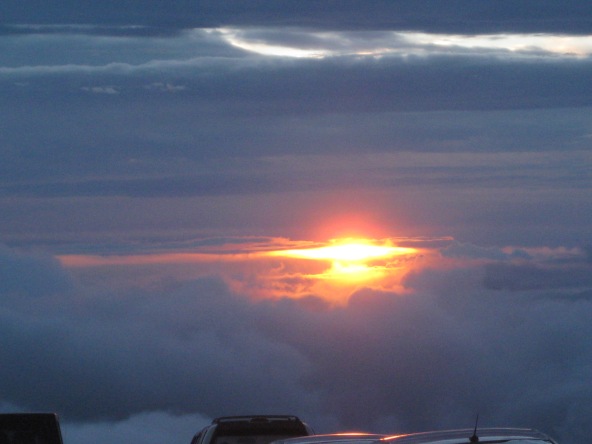
Anyway, what we saw of the Majestic Haleakala Sunrise, jockeying as we were for a place among the thronging crowds that stood holding all manner of cameras and personal recording devices in the pre-dawn cold, was…well, it was a nice sunrise. I have seen other people’s pictures of it which looked better than what we saw, so bear that in mind. Still, Sylvia and I were not overly impressed.

What happened next though, was impressive.
Slowly at first, and then in a mad dash, the gaggles of tourists who had flocked to the summit at dawn began to abandon the mountaintop. It escalated quickly into the highest altitude traffic jam I have ever witnessed, complete with cars cutting each other off, pedestrians scrambling frantically out of the way, and rude and surly people honking and screaming at each other. Sylvia and I strolled the summit, not wishing to be part of this madness, and meanwhile waiting for the copious morning fog to clear.

Within an hour of the sunrise, almost everyone was gone. Only a few cars and buses remained in the wide parking lot. Sylvia and I, together with a few intrepid others, had the windswept summit all to ourselves.
Descent into the Underworld
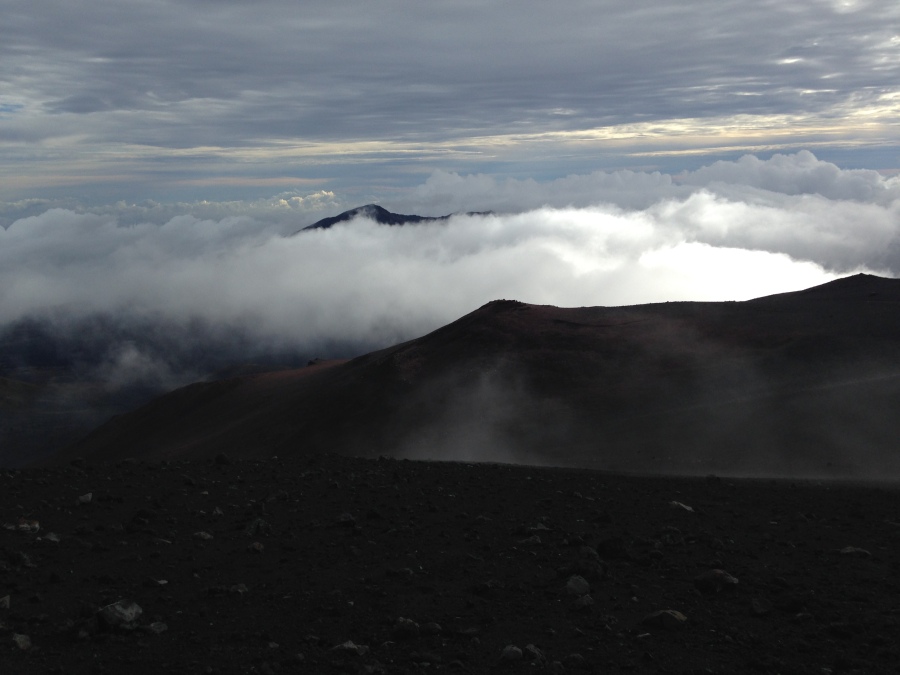
The Haleakala Crater is an impressive and otherworldly place, well worth seeing at any time of day. The air clarity is so astonishing they built a large observatory here just a few hundred feet away (it is not accessible to the public.) The crater itself was not actually formed by any eruption. Hawiian shield Volcanos do not typically erupt with the same explosive force of Mount St. Helens, say, whose tumultuous, steaming caldron I had viewed from close up in 2008. Instead, it likely formed when the mountain around it simply washed away due to the natural forces of erosion. Strictly speaking, this makes it not a volcanic crater at all but a valley…whatever it is, the crater is undoubtedly one of the weirdest and most unique places on Earth.
The adventure begins at the top, at the interpretive center atop of the wind-swept rim. We had taken only light Camelback type packs with us, mostly because we couldn’t carry much else in the luggage. We therefore started downward wearing all our layers (it was perhaps 40 degrees and windy), de-layering as we went and the day warmed up around us. Transport of the shed layers without real packs proved somewhat problematic…I ended up tying several of them around my shoulders and waist, the result being that I looked a little like a cross between Lawrence of Arabia and a travelling gypsy camp. I do not recommend this look.

Decent via the Sliding Sands trail affords the hiker a continuously remarkable view. First come glimpses of the huge Volcanoes of Mauna Loa and Mauna Kea, seeming to loom very close despite being nearly 100 miles away on the Big Island. As you go further, the walls close in and oddly colored vistas of ash and rock appear.
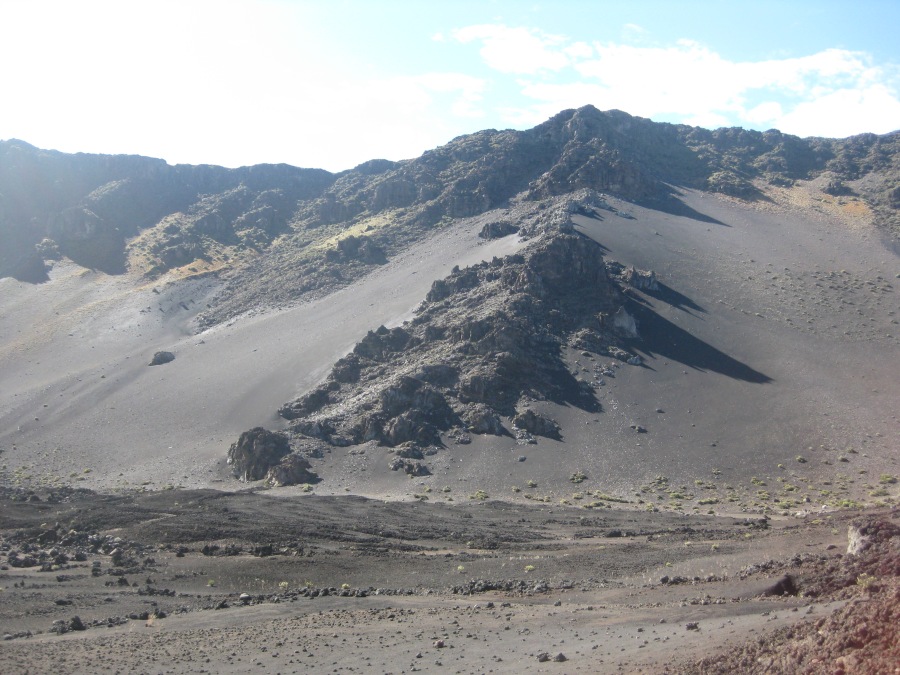
Here’s the NPS website for the trail….
https://www.nps.gov/hale/planyourvisit/hiking.htm
The trail itself is pretty easy, with neither the razor-sharp pumice rock I had seen in evidence on St. Helens, nor the deep, shifting power ash I had also witnessed there and would later encounter on Misti. On the upper reaches of the trail we had some company, but after perhaps a mile, we had the place all to ourselves.
The crater is a strange, silent place. It seems far more remote than any other place on the island, where you are seldom far from the crash of surf or the roar of motors and people. All here is dead quiet. You feel, as the wispy veils of clouds untangle around you and reveal otherworldly landscapes, that you are walking back in time, to an era far earlier than the dawn of man.
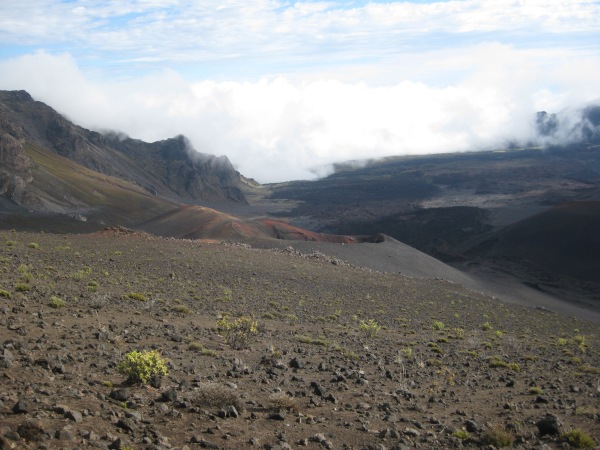
A couple of miles in we came upon the first grove of the remarkable silverswords of Haleakala…a plant found nowhere else on Earth. Though they can live up to 90 years, they flower only once, at the end of their life, and then die. A great many of these weird gems of the volcano were in evidence along the trail.
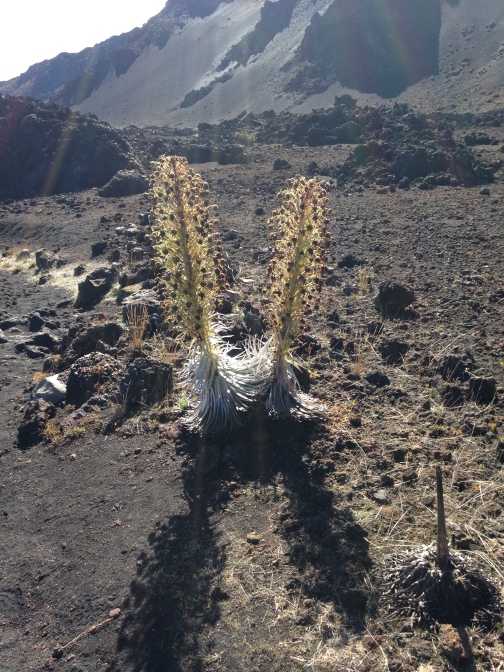
https://www.nps.gov/hale/learn/nature/silversword.htm
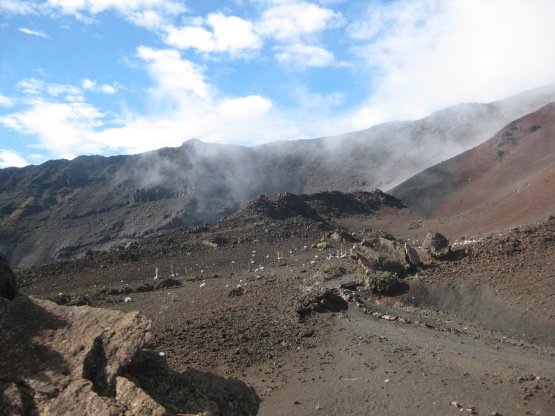
Further in, as the mists of morning peel back, you get a good view into of some of the gaping volcanic cinder cones that line the broad valley. These ominous looking natural smokestacks yawn cavernously from the underworld and seem as if they might rumble to life at any moment…though most have in fact been inactive for many lifetimes.
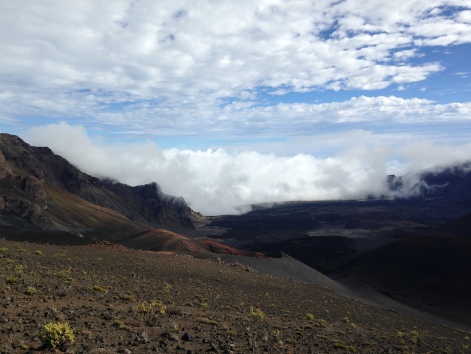


Near the bottom of the valley the trail winds by a vast lake of broken rock that was once a lava flow. This singularly impressive place looked almost to me like a marching army whose soldiers had been turned to stones where they stood…or a fantastic array of upended tombstones. Everywhere was the weirdness of volcanic rock. Compared to the rough, jagged pumice of St. Helens, the stuff of Haleakala felt light, hollow and porous. Years later on Misti, I would observe that it was made of very similar lightweight volcanic rock.
At the bottom of the valley is a small stand of bushes by a junction of trails, and here, with the great walls of the crater looming up over us, we paused for lunch. Eventually a pair of Japanese tourists ambled by (we had seen them coming behind us for hours) but otherwise we had this place to ourselves. The trail continues for many more miles before eventually leaving the crater and re-entering the jungle. Out there somewhere is an NPS shelter where those who do not fear the wrath of the volcano can spend the night. What an eerie thing that must be, to be alone in at the bottom of the silent cauldron by starlight!

But we were not going to stay the night, a comfortable hotel bed by the beach awaited us. And so we began, not without reluctance, the long slow climb out of the crater back up to 10,000 feet.
Despite my motley attire, we had no issues with the inbound leg of this trek. Our walking at elevation a year or two earlier in Peru on the Salkantay Trail had prepared our bodies. Sylvia practically ran up the trail leaving me behind. Last I checked, the two Japanese tourists were miles behind us, but still climbing doggedly. I think they made it out fine.
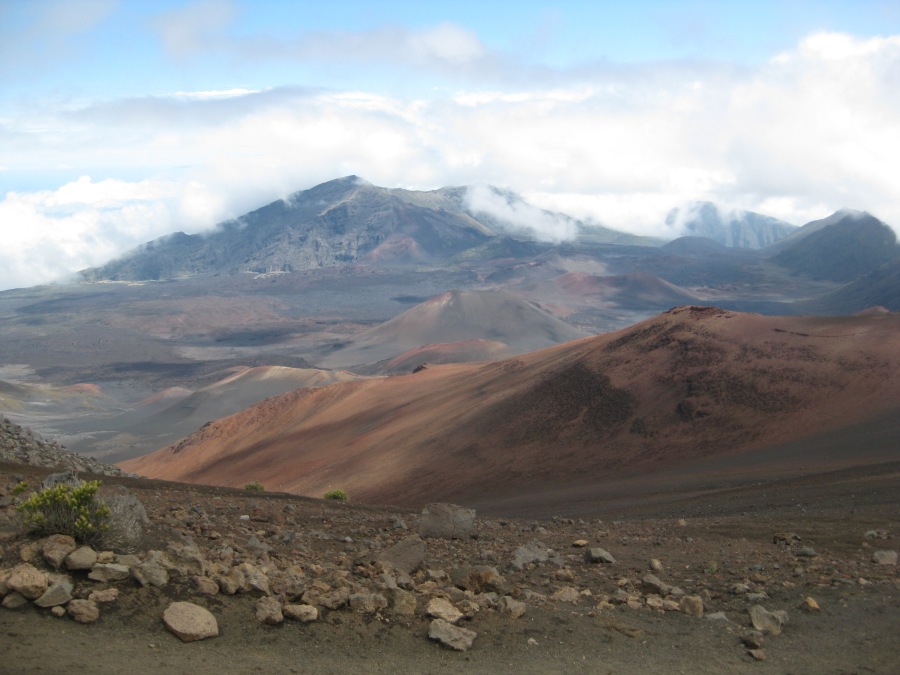
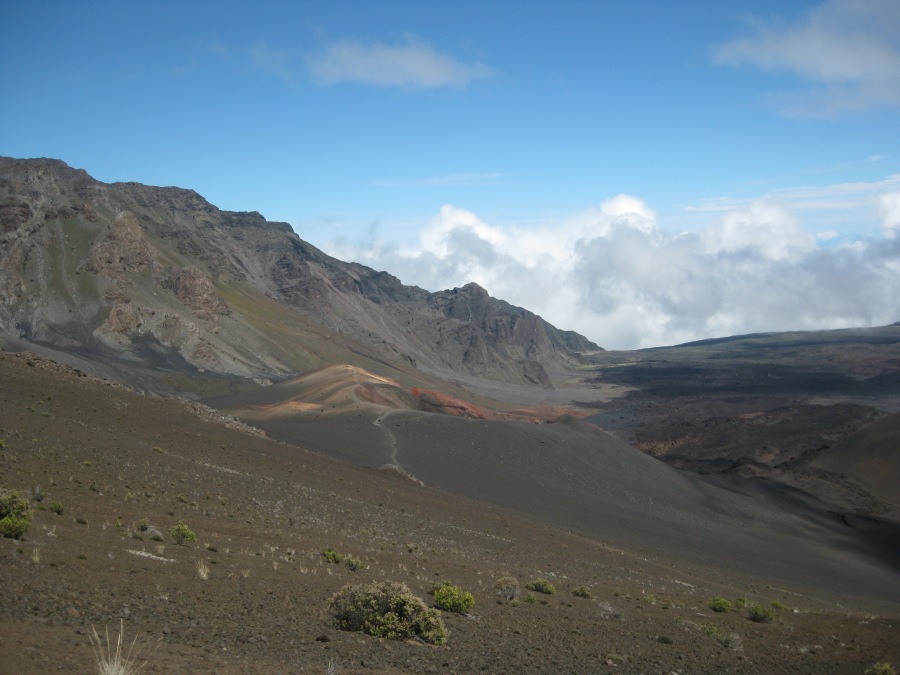
Our trip back contained one more amusing episode. Deep in the rim of the crater I had observed at close range a pigeon-like ground bird foraging near our lunch spot. I immediately seized upon the idea that this was some rare species of fauna endemic to the volcano…and considered myself lucky to have glimpsed this seldom seen creature in its native habitat.
Hours later…Back up at the parking lot at the rim, I was walking toward the visitor center, busy congratulating myself on a job well done. From behind a parked mini bus steps…the very same bird, foraging now on crumbs left upon the asphalt. The bird was a Chukar Patridge…a Eurasian game bird and an invasive species to Hawaii.
The amusing episode of the partridge does bring up a much less amusing point about our travels on Maui, which you seldom read or hear about. And this is the absolute devastation of the native flora and (especially) fauna by invasive species. Virtually all the wildlife endemic to the island has been wiped out by human-introduced invasive species such as rats, mongoose, pigs, cats, dogs, and garden variety birds such as sparrows and finches. Virtually every bird you see is a common ‘city type’ bird you might witness in any downtown park in North America or Europe. It is one very sad postscript to the otherwise sunny travelling on this island paradise.
The drive down Haleakala is by the way MUCH less stressful than the ride up, especially because you get to do it in broad daylight. Just be careful of the many road bikers who pay to be shuttled to the top so they can coast downhill.

Put that one in the Bucket (List)!
All in all, I would rate the Haleakala Crater hike via the Sliding Sands trail as one of the best hikes we have ever done, and I do consider it one of our all time “Bucket List” hikes. I would personally advise that you carefully consider before following the herd and doing the same mad dash of the “Alpine Road Start” that thousands take to see the admittedly amazing sunrise. Do NOT get trapped into the herd mentality…there is FAR MORE to see here than just the sunrise.

In fact, where I to do it over again, I would almost certainly stay to see the sunset instead, and then do the downhill drive, more slowly and leisurely, in the twilight. Save the worst of the darkened driving for the flatlands.
But even with the perils of the mad dash we were glad to have made the early start. We did manage to glimpse a split-second view of a rare Hawaiian Owl (one of the last remaining examples of rare fauna left on the island) in our headlights, which we would have not have done had we come after daybreak. We also very much enjoyed the hike after the tourists had gone.

Our opinion is that anyone of reasonable fitness can do this trail…there are no unusually steep sections or challenges and footing is generally good despite the somewhat crumbly ash. I would strongly caution anyone who attempts this to beware the altitude…at over 10,000 feet the rim is more than high enough to trigger altitude sickness. And remember that the hike begins going DOWN hill, so you may not feel the effects of this until you start upward…when you will already be tired at the end of a long hike. And the symptoms will only get worse as you go higher.
Proper conditioning is necessary, and experience with altitude helps. Also, be aware that while this hike is located in the tropics, the rim of the volcano is NOT tropical. The average nightly low temperature on the summit varies between 30-40 degrees F and can go lower, so dress properly. And do not forget the sunscreen, UV rays are strong here.
Sylvia and I were well prepared and had no issues at all with this trail.
If you have a bucket list – or even if you don’t – be sure to add a hike of Haleakala’s amazing crater to your list of adventures. You won’t be disappointed!
ALOHA!!!
(All photos by the authors.)
